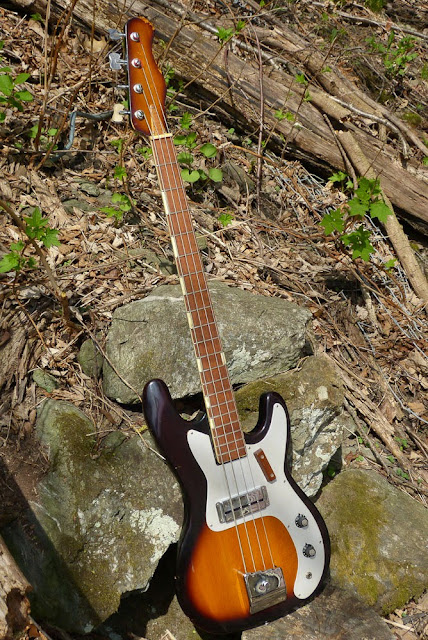1965 Teisco EB18 Electric Bass
Update: I took this bass in trade from my buddy last year and have since added an older Fender (American?) hard case to it, adjusted a few things further, and installed some LaBella flatwound strings after it transferred to me. It's a great, vintage-sounding bass with a fat-as-heck bottom that permeates every playing environment I've used it in. Bass players who've used it off and on have all been in love. It's a bit like a P-bass on steroids. You can get a bit of pseudo-upright tonality to it, too, if you string-dampen with some foam under the bridge cover. Anyhow, here's the case:
And now back to the original post...
While this is a friend's bass (in for work), I remember a period a couple years ago where I was scrounging for one of these for myself. This one dates to '65 which I found out via this helpful forum info. They're very cool basses if they can be properly setup, but most are in beat condition these days. This one arrived here in a mostly-original state, though the frets had been replaced (amateur-style) with jumbo stock and the usual Teisco conditions applied: poor intonation at the bridge, somewhat funky neck, no-longer-adjusting adjustable truss rod... that kind of stuff.
My work on this one was to finish-off the fret job which included a level/dress and some minor tweaking to fret seating where I could, intonation (via modification) of the bridge saddles, general cleaning, tuner disassembly/lube, and setup. It now plays well, though it does have a bit of wonkiness still left in the neck which means it can't be "modern spot on" like a good Warmoth-issue neck might be able to do. It's more "Squier spot on," if you know what I mean. Most bass players wouldn't notice and the action is comfortable and easy with 3/32" overall at the 12th fret (though a light-touch player can drop it a little on the treble end).
This bass is almost on par with P-bass dimensions, though the body feels slightly narrower and thinner and the scale length is 33 1/2" rather than a full 34" long scale. It's a solid (not laminate) body with a sunburst sprayed on it and the pickguard is (close to my heart) thick aluminum which aids as a shield as well.
The neck is 3-piece mahogany with a rosewood fretboard and offset fret markers. I'm amazed the mahogany truss cover has survived... along with the original plastic nut. The neck profile is a big old C/V hybrid shape.
Now, the old refret job wasn't ideal for a few reasons: most noticeable is that the fellow who refretted this didn't level the neck off before he did the work. This is the #1 important bit to get right before refretting. #2 is that the fret ends weren't secure in their slots -- so either the wood was chewed up and they really needed to be "tack glued" into place, or the frets themselves hadn't been radiused before install. Either way, it meant that a regular level/dress of the frets was a bit more time-consuming and frustrating.
Usually when I refret a neck, one sweep of 220-grit paper is all I need to make sure all the frets are dead-level with one another... because just like painting a house... it's all the prep work that adds up to a good job.
I love the styling.
Now, the main reason this bass is great is that big old pickup. It sounds like a fat P-bass. Why? It looks single-coil, doesn't it? But -- it's actually a split-coil, humbucking pup, just like a P-bass pickup. Rad!
The pickup does grab some body noise which gives it a very "live" sound that's very tasty -- especially recorded. This hasn't been an issue with feedback or amp choice, however, as I've played it pretty loud with groups without issue in that regard.
The pickup does grab some body noise which gives it a very "live" sound that's very tasty -- especially recorded. This hasn't been an issue with feedback or amp choice, however, as I've played it pretty loud with groups without issue in that regard.
After cleaning up the electronics I pondered on the tone knob until I realized that it just functions backwards from normal. Zero is actually your usual "wide open."
After working on the neck, my next mod was to make the bridge practical. Two-saddle bridges never intonate correctly, so I added the compensation myself with a flat file -- just like you'd see on modern compensated Tele saddles. I also found out that, excellently, the saddles are plated brass. She now plays in tune up the neck.
I also had to do the usual fussing-around with import bridges -- cutting-down adjustment screws, snipping the springs to allow longer travel for adjustment, that sort of thing.
I adore the tummy-cut and rounded-off heel area. It's like a Mosrite/Fender lovechild that grew up on Tokyo surf.
The tuners are original and work just fine.

















Comments
it appears that the pickup in this bass is actually a single coil.
i just acquired a similar vintage instrument with two of these pickups.
they are actually assembled in this order:
the magnets lay in the body cavity on foam
the coils are placed over the magnet assemblys (coils, pots and jack soldered prior and attached to the pickguard;
the pickguard is placed over the assemblys and gold covered insulating strips are place over the "pole pieces" and the cover over it all.
yikes. pictures upon request.
best regards,
michael lindner
Sounds fantastic
All of the things you described